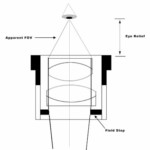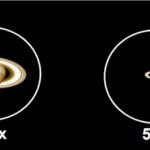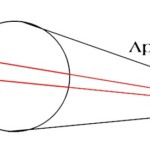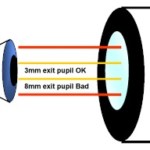
31 Nagler, 56 Meade Super Plossl, 41 Panoptic, 6 Radian, 40 Sirrus Plossl, 32 Plossl, 25mm Plossl and 6mm Plossl
Selecting a good quality eyepiece can be daunting for the beginner. Few are cheap and you want to get the most for your money. The next few pages are designed to help you calculate eyepiece magnification, field of view and exit pupil for your telescope.

Calculating Magnification

To compute the magnification of an eyepiece divide the telescope focal length by the eyepiece focal length:
Power = Scope Focal Length (mm) / Eyepiece Focal Length (mm)
Examples:
C-8 with an aperture of 203 mm and focal ratio of 10 = 2030 mm
Power with a 20 mm ep = 2030 mm / 20 mm = 101x
8” f/6 newt = 8” * 25.4 mm/inch * 6 = 1220 mm focal length
Power with a 20 mm ep = 1220 mm / 20 mm = 61x
Calculating Field of View
Apparent (afov) versus True Field of View (fov)
The apparent field of view is determined by the manufacturer and is the area of the sky that the eye sees. The true field is amount the sky actual seen through the eyepiece when it’s attached to a telescope.

Commonly used equation:
fov in degrees = afov / Magnification
Example: fov = 65 degs / 61x = 1.06 degs
More Accurate Equation
requires field stop specification for eyepiece
Fov = field stop (mm) * 57.3 (deg/radian) / Scope Focal length (mm)
Example (19 mm Panoptic in 9.25” F/10 SCT):
Fov = 21.3 mm * 57.3 / 2350 = 0.52 degs
Calculating Exit Pupil
The exit pupil is the size of light cone exiting the eyepiece.

The light exiting the eyepiece should fit inside your dark adapted pupil as it does with the 3mm yellow light rays above. An 8mm exit pupil (red ray) may be too large for your pupil and wastes light.
Exit Pupil = EP Focal Length (mm) / Scope Focal Ratio (f/#) or
Exit Pupil = Scope Aperture (mm) / Magnification
Examples:
55 Plossl (best suited to longer focal ratio scopes):
f/10 SCT = 55 mm / 10 = 5.5 mm
f/5 newt = 55 / 5 = 11 mm
or
35 Panoptic or 35 Plossl:
f/6 = 35 / 6 = 5.8 mm
f/4.5 = 35 / 4.5 = 7.8 mm
Examples at the small end:
5 mm eyepiece:
f/10 8” SCT => 5 / 10 = 0.5 mm exit pupil, 406x power
Why 50x/inch?
1” = 25.4 mm => 25.4 / 50 x = 0.5 mm exit pupil
Department Store Tasco Power
60 mm scope at 675x = 60 / 675 = 0.09 mm exit pupil!
Many rules of thumb:
You often get the best contrast at exit pupils of 1 to 3 mm
Remember the 50x per inch of aperture inch limit for scopes
Nominal range for most people is 0.5 to 6 mm
Pupil of dark adapted eye typically opens to 6 to 7 mm
If the exit pupil is larger than your dark adapted eye, you’ll lose light.


You must be logged in to post a comment.